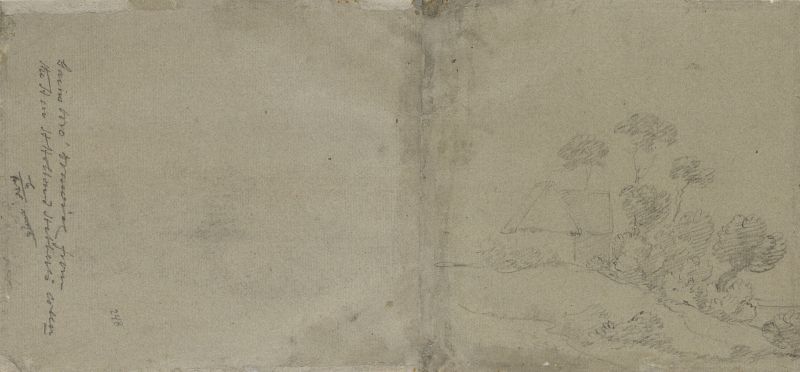This rapidly executed pencil study of a clump of trees was made by Gainsborough whilst he was still in his native Suffolk at the end of the 1750s. Gainsborough’s friend and obituarist, the Reverend Sir Henry Bate Dudley wrote in 1788 that: ‘Nature was his teacher and the woods of Suffolk his academy; here he would pass in solitude his moments in making a sketch of an antiquated tree, a marshy brook, a few cattle, a sheep herd and his flock, or any other accidental objects that were present.’[1]
This drawing, made up of two sheets stuck together, belongs to a group of drawings of the same period which are also focused plein air studies and it was almost certainly part of a now dismembered sketchbook. According to Joseph Farington a group of sketchbooks were sold by the artist’s daughter Margaret in 1799 for £140.3s.6d.[2] Of the ten books offered for sale at Christie’s, three were acquired by the West India merchant and collector George Hibbert, one by the collector and connoisseur Richard Payne Knight, one bought in half-shares by Hibbert and Sir George Beaumont, one was acquired by the dealers Colnaghi’s and ‘Mr Pugh’, the artist Hugh Pugh, also bought three.[3] The present sheet comes from one of the Hibbert sketchbooks.
The purpose of such studies was clearly to inform Gainsborough’s own practice as a landscape painter. The close observation of a tree allowed him to understand the construction of the plant, the massing of lights and shadows and the way the foliage behaved in different weather and seasons. Gainsborough was clearly working out the structure of the tree and the arrangement of the foliage without drawing every leaf, a method which was informed at this date by his interest in Dutch landscape painting of the seventeenth century. This drawing is singular in Gainsborough's oeuvre, showing him deliberately studying a single tree over two sheets of a sketchbook opening. These sheets ultimately informed Gainsborough’s practice as a landscape painter, but rather than providing templates from which he could quote in his paintings, they acted as exercises, allowing him to work out a method of drawing individual trees back in his studio. Gainsborough articulated the idea that these studies acted as exercises rather than formal drawings in a letter to his patron, Constantine Phipps, who he was teaching to draw:
You know, Sir, I set you to this [sketch of foliage] merely to free your hand, but you are not to understand that for Drawing – therefore remember that there must be truth of hand, as well as freedom of hand in Drawing.[4]
The present sheet has a small study of a cottage on the verso, which was accepted as autograph by Hayes.
References
- The Morning Herald, 8 August, 1788.
- Ed. Kenneth Garlick and Angus Macintyre, The Diary of Joseph Farington, New Haven and London, 1979, IV, p.1222.
- John Hayes, The Drawings of Thomas Gainsborough, London, 1970, I, p.96.
- Thomas Gainsborough to the Hon Constantine Phipps, later 2nd Baron Mulgrave, in ed. John Hayes, The Letters of Thomas Gainsborough, New Haven and London, 2001, p.92.



